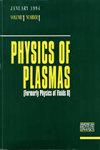Design and modeling of indirectly driven magnetized implosions on the NIF
IF 2.2
3区 物理与天体物理
Q3 PHYSICS, FLUIDS & PLASMAS
引用次数: 0
Abstract
The use of magnetic fields to improve the performance of hohlraum-driven implosions on the National Ignition Facility (NIF) is discussed. The focus is on magnetically insulated inertial confinement fusion, where the primary field effect is to reduce electron-thermal and alpha-particle loss from the compressed hotspot (magnetic pressure is of secondary importance). We summarize the requirements to achieve this state. The design of recent NIF magnetized hohlraum experiments is presented. These are close to earlier shots in the three-shock, high-adiabat (BigFoot) campaign, subject to the constraints that magnetized NIF targets must be fielded at room-temperature, and use ≲1 MJ of laser energy to avoid the risk of optics damage from stimulated Brillouin scattering. We present results from the original magnetized hohlraum platform, as well as a later variant that gives a higher hotspot temperature. In both platforms, imposed fields (at the capsule center) of up to 28 T increase the fusion yield and hotspot temperature. Integrated radiation-magneto-hydrodynamic modeling with the Lasnex code of these shots is shown, where laser power multipliers and a saturation clamp on cross-beam energy transfer are developed to match the time of peak capsule emission and the P2 Legendre moment of the hotspot x-ray image. The resulting fusion yield and ion temperature agree decently with the measured relative effects of the field, although the absolute simulated yields are higher than the data by 2.0−2.7×. The tuned parameters and yield discrepancy are comparable for experiments with and without an imposed field, indicating the model adequately captures the field effects. Self-generated and imposed fields are added sequentially to simulations of one BigFoot NIF shot to understand how they alter target dynamics.NIF 间接驱动磁化内爆的设计和建模
本文讨论了如何利用磁场来提高国家点火装置(NIF)上豪仑驱动内爆的性能。重点是磁绝缘惯性约束聚变,在这种情况下,磁场的主要作用是减少压缩热点的电子-热和阿尔法粒子损耗(磁压力是次要的)。我们总结了实现这种状态的要求。介绍了最近的 NIF 磁化真空实验的设计。这些实验与早期的三冲击、高adiabat(BigFoot)活动中的实验相近,但受限于磁化 NIF 目标必须在室温下进行,并且使用≲1 兆焦耳的激光能量以避免受激布里渊散射造成光学器件损坏的风险。我们展示了最初的磁化真空平台以及后来的变体平台的结果,后者能提供更高的热点温度。在这两个平台中,外加磁场(在舱中心)高达 28 T,可提高核聚变产率和热点温度。利用 Lasnex 代码对这些射流进行了辐射-磁场-流体动力学综合建模,其中开发了激光功率倍增器和跨束能量传递饱和钳,以匹配胶囊发射峰值时间和热点 X 射线图像的 P2 Legendre 矩。尽管模拟的绝对产率比数据高出 2.0-2.7 倍,但得出的聚变产率和离子温度与测量的场相对效应相当吻合。在有外加场和无外加场的实验中,调谐参数和产率差异相当,表明模型充分捕捉到了场效应。将自生场和外加场依次添加到 BigFoot NIF 一次发射的模拟中,以了解它们是如何改变目标动态的。
本文章由计算机程序翻译,如有差异,请以英文原文为准。
求助全文
约1分钟内获得全文
求助全文
来源期刊

Physics of Plasmas
物理-物理:流体与等离子体
CiteScore
4.10
自引率
22.70%
发文量
653
审稿时长
2.5 months
期刊介绍:
Physics of Plasmas (PoP), published by AIP Publishing in cooperation with the APS Division of Plasma Physics, is committed to the publication of original research in all areas of experimental and theoretical plasma physics. PoP publishes comprehensive and in-depth review manuscripts covering important areas of study and Special Topics highlighting new and cutting-edge developments in plasma physics. Every year a special issue publishes the invited and review papers from the most recent meeting of the APS Division of Plasma Physics. PoP covers a broad range of important research in this dynamic field, including:
-Basic plasma phenomena, waves, instabilities
-Nonlinear phenomena, turbulence, transport
-Magnetically confined plasmas, heating, confinement
-Inertially confined plasmas, high-energy density plasma science, warm dense matter
-Ionospheric, solar-system, and astrophysical plasmas
-Lasers, particle beams, accelerators, radiation generation
-Radiation emission, absorption, and transport
-Low-temperature plasmas, plasma applications, plasma sources, sheaths
-Dusty plasmas
 求助内容:
求助内容: 应助结果提醒方式:
应助结果提醒方式:


